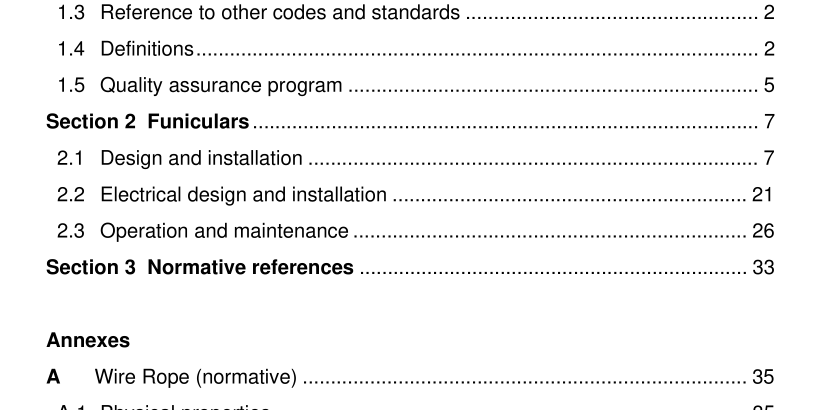ANSI B77.2-2020 pdf download.for Funiculars – Safety Requirements
It is recognized that certain dangers and risks are inherent in machines of this type and their operation. It is also recognized that inherent and other risks or dangers exist for those who are in the process of embarking, riding, or disembarking from funiculars. This system is intended to result in funiculars that are designed, constructed, operated, and maintained in a manner that helps reduce danger, exposure to risk to passengers and maintenance and operational personnel, and to encourage improvements in productivity, efficiency, development, and progress consistent with the objectives. Such a system with these stated objectives constitutes a safety standard.
1.2.1 Other classifications
Funicular configurations that do not fall within the definition specified in 1 .4 – funicular, but fall within the general category of funiculars should be evaluated by the authority having jurisdiction based upon the design engineer’s specifications and the applicable provisions of this standard.
1.2.2 New materials and methods for funiculars
Adoption of technological improvements in materials and advances in techniques is essential to enable the industry to keep pace with progress. If a designer or manufacturer proposes to use materials or methods not covered by this standard, those materials, methods, or both, shall be clearly identified. Complete design and test information shall be provided to the purchaser or the owner and the authority having jurisdiction (see 1 .4 – authority having jurisdiction).
1.2.3 Exceptions
Strict application of the provisions of this standard may not be appropriate in every instance. Wherever it may be proposed to depart from the provisions of this standard, the authority having jurisdiction may grant exceptions from the literal requirements or permit the use of other devices or methods that provide features comparable to those included in this standard.
1.2.4.1 Existing installations
Existing installations, and those with design review completed by the authority having jurisdiction prior to the effective date of this standard, need not comply with the new or revised requirements of this edition, except where specifically required by the authority having jurisdiction. Operation and maintenance shall be in compliance with those requirements specifically listed (not included by reference) in the operation and maintenance subsection 2.3. and normative Annexes A and F in the most current edition of this standard.
1.3 Reference to other codes and standards
The design, installation, operation, and maintenance of funiculars and their components that are not covered by this standard should conform to applicable standards or codes. To the extent that they are available, applicable codes or standards shall be selected to cover all features, including, but not limited to, ADA, allowable unit stresses, and properties of materials. Each code or standard should be of the most recent issue, and the designer shall state which code or standard was followed. Features not covered by this standard, shall be handled in accordance with sound engineering judgment to the satisfaction of the authority having jurisdiction.
bullwheel: A large grooved wheel at a terminal that rotates continuously when the haul rope is moving and deflects the haul rope by an angle of 1 0 degrees or more. bullwheel, deflection: A bullwheel that deflects the haul rope at least 1 0 degrees. bullwheel, diameter of: Wherever the term diameter is used in specifying bullwheels, it refers to the diameter at the bottom of bullwheel grooves (tread diameter). bullwheel, drive: A bullwheel that delivers power to the haul rope. bullwheel, fixed return: When acting simply as a fixed return for the haul rope. bullwheel, tension: A bullwheel that maintains tension in the haul rope by changing its position. cabin, enclosed: A cabin utilized for the transportation of passengers in which no part of the passenger can extend more than 6 inches horizontally through any opening, including windows and doors. cabin, open: A cabin utilized for the transportation of passengers in which passengers can enter or exit through open doors or the sides of the cabin, or when windows are not covered allowing passengers outside access during operation.ANSI B77.2-2020 pdf download
